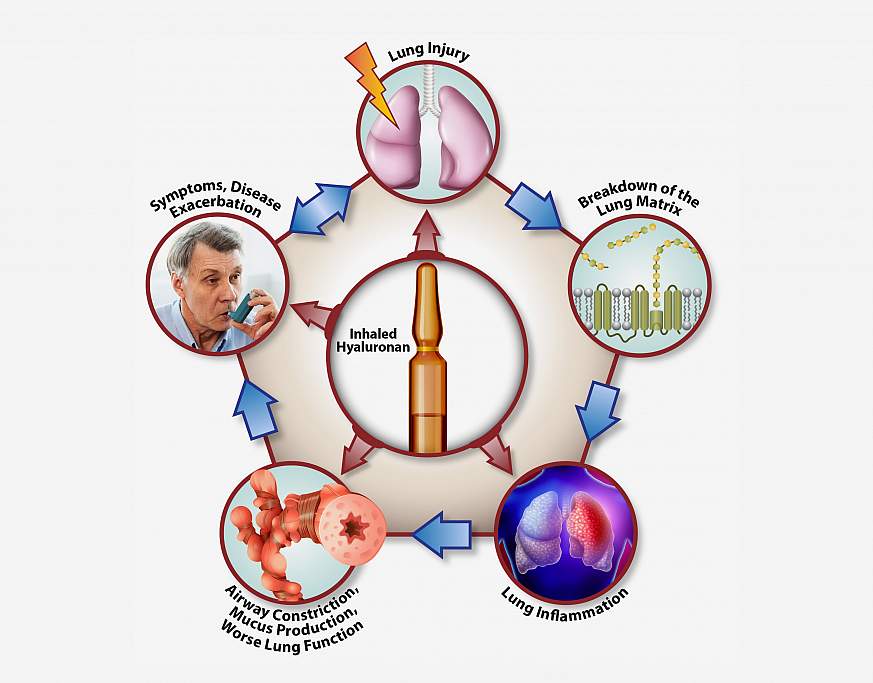You are here
News Release
Monday, February 1, 2021
NIH study shows hyaluronan is effective in treating chronic lung disease
Naturally produced by the body, hyaluronan represents a new class of biologic that significantly improves lung health in patients with severe COPD.

Researchers at the National Institutes of Health and their collaborators found that inhaling unfragmented hyaluronan improves lung function in patients suffering from severe exacerbation of chronic obstructive pulmonary disease (COPD). Hyaluronan, a sugar secreted by living tissue that acts as a scaffold for cells, is also used in cosmetics as a skin moisturizer and as a nasal spray to moisturize lung airways. Utilized as a treatment, hyaluronan shortened the amount of time COPD patients in intensive care needed breathing support, decreased their number of days in the hospital, and saved money by reducing their hospital stay.
The study, published online in Respiratory Research, is a good example of how examining the impacts of environmental pollution on the lungs can lead to viable treatments. Several years ago, co-senior author Stavros Garantziotis, M.D., medical director of the Clinical Research Unit at the National Institute of Environmental Health Sciences (NIEHS), part of NIH, showed that exposure to pollution causes hyaluronan in the lungs to break down into smaller fragments. These fragments irritate lung tissue and activate the immune system, leading to constriction and inflammation of the airways. He determined that inhalation of healthy, unfragmented hyaluronan reduces inflammation by outcompeting the smaller hyaluronan fragments.
Garantziotis offered an analogy for how the inflammation occurs. He said hyaluronan surrounds cells like mortar surrounds bricks. Introducing pollution causes cracks in the mortar, breaking it into smaller chunks.
"These smaller chunks irritate the body and activate the immune system, leading to inflammation," Garantziotis said. "Reintroducing the full-length hyaluronan, like a fresh coat of mortar, means it is less irritating and reduces the amount of inflammation."
Since hyaluronan was approved in Italy for airway moisturization, Garantziotis worked with colleagues in Rome to see if inhalation of full-size hyaluronan could improve lung function in critically ill COPD patients. He explained that the patients were using a breathing apparatus similar to a continuous positive airway pressure (CPAP) machine to treat their acute exacerbation of COPD. This apparatus provided breathing support by blowing air into the airways through a mask.
"Inhaled hyaluronan qualifies as a stimulating aid for patients with exacerbated COPD, as it is safe and easy to administer,” said co-senior author Raffaele Incalzi, M.D., Department of Medicine, Campus Bio-Medico University and Teaching Hospital, Rome. "Furthermore, it acts locally, only in the bronchial tree, and, thus, cannot interfere with any systemic drug."
Garantziotis also wanted to know what was producing airway constriction in the lungs of COPD patients. He theorized that thick mucus may be involved. Collaborating with scientists at the University of Alabama at Birmingham (UAB), they grew airway cells from emphysema patients in culture and looked at how mucus moved in the cells. They saw that mucus flowed more easily after administering hyaluronan.
Co-author Steven Rowe, M.D., director of the Gregory Fleming James Cystic Fibrosis Research Center at UAB, said if patients with severe COPD took hyaluronan, the treatment would improve mucus transport and aid their recovery.
Current treatments for lung disease include inhaled steroids, antibiotics, and bronchodilators, so using a molecule that is already found in the body is a new concept. The goal now for Garantziotis is to study this treatment in more patients in the U.S., so he can understand the optimal conditions and dosing that will produce the most benefit.
About the National Institute of Environmental Health Sciences (NIEHS): NIEHS supports research to understand the effects of the environment on human health and is part of the National Institutes of Health. For more information on NIEHS or environmental health topics, visit https://www.niehs.nih.gov/ or subscribe to a news list.
About the National Institutes of Health (NIH): NIH, the nation's medical research agency, includes 27 Institutes and Centers and is a component of the U.S. Department of Health and Human Services. NIH is the primary federal agency conducting and supporting basic, clinical, and translational medical research, and is investigating the causes, treatments, and cures for both common and rare diseases. For more information about NIH and its programs, visit www.nih.gov.
Grant Numbers: Z01ES102605, Z01ES102465, R35HL135816, P30DK072482
About the National Institutes of Health (NIH): NIH, the nation's medical research agency, includes 27 Institutes and Centers and is a component of the U.S. Department of Health and Human Services. NIH is the primary federal agency conducting and supporting basic, clinical, and translational medical research, and is investigating the causes, treatments, and cures for both common and rare diseases. For more information about NIH and its programs, visit www.nih.gov.
NIH…Turning Discovery Into Health®
References
Galdi F, Pedone C, McGee CA, George M, Rice AB, Hussain SS, Vijaykumar K, Boitet ER, Tearney GJ, McGrath JA, Brown AR, Rowe SM, Incalzi RA, Garantziotis S. 2021. Inhaled high molecular weight hyaluronan ameliorates respiratory failure in acute COPD exacerbation: a pilot study. Respir Res: doi: 10.1186/s12931-020-01610-x.
